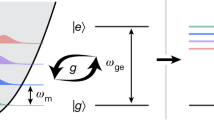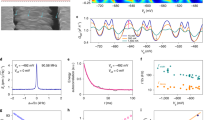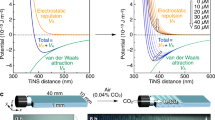Abstract
It has been almost forgotten that the first computers envisaged by Charles Babbage in the early 1800s were mechanical1,2 and not electronic, but the development of high-frequency nanoelectromechanical systems is now promising a range of new applications3, including sensitive mechanical charge detectors4 and mechanical devices for high-frequency signal processing5, biological imaging6 and quantum measurement7,8,9. Here we describe the construction of nanodevices that will operate with fundamental frequencies in the previously inaccessible microwave range (greater than 1 gigahertz). This achievement represents a significant advance in the quest for extremely high-frequency nanoelectromechanical systems.
Similar content being viewed by others
Main
Until now, it has not been possible to create mechanical devices that operate at extremely high frequencies, owing to the dual challenge of detecting tiny displacements (on the scale of femtometres) at microwave frequencies1,3. The characteristic frequency of nanoelectromechanical systems (NEMS) scales upwards with decreasing size, but their displacement (when operating linearly) and their electromechanical impedance both simultaneously scale downwards.
Two advances have been crucial to breaking the 1-GHz barrier in NEMS: the use of silicon carbide epilayers10, which are of comparable density but are significantly stiffer than the usual silicon11,12, and which allow higher frequencies to be attained for structures of similar geometry; and the development of balanced, high-frequency displacement transducers, which enable the ubiquitous passive embedding impedances that arise from electrical connections to the macroworld to be nulled13 (if uncontrolled, these parasitic impedances overwhelm the electromechanical impedance of interest — the 'signal' — in ultrasmall NEMS).
We used 3C–SiC films that were grown hetero-epitaxially at atmospheric pressure by chemical-vapour deposition in an induction-heated reactor on 100-mm-diameter (100) Si wafers10. Device nanofabrication involves both optical and electron-beam lithography to define, respectively, large-area contact pads and submicrometre-scale, thin metallic-film masks with the device geometry. Pattern transfer to the 3C–SiC layer is achieved by an electron cyclotron resonance (ECR) plasma-etch step involving an NF3/O2/Ar mixture. The patterned 3C–SiC beams are then suspended above the underlying silicon substrate by using an isotropic NF3/Ar ECR etch. The metallic mask (30 nm of aluminium, followed by 5 nm of titanium), deposited by e-beam evaporation and patterned by lift-off, remains on the beams and is used as the electrode for displacement transduction. The devices consist of two nominally identical, doubly clamped beams, roughly 1.1 µm long, 120 nm wide and 75 nm thick.
Each doubly clamped beam pair is positioned perpendicular to a strong magnetic field (3–8 tesla) in vacuo within a liquid-helium cryostat. Balanced magnetomotive detection is used13; when the driving frequency matches the fundamental frequency of the in-plane flexural mode for one of the beams, there is resonant enhancement of the induced electromotive force. This response is pre-amplified and characterized by a microwave-network analyser.
Fundamental mechanical resonances are detected at 1.014 GHz and 1.029 GHz for the two beams (Fig. 1). So far, quality factors attained above 1 GHz (about 500) are substantially lower than observed for NEMS in roughly the 100-MHz range (about 104). Having ruled out factors such as electrical damping, we are investigating whether this stems from roughness in the initial SiC epilayers, and how such sources of acoustic loss in microwave NEMS can be minimized. Nonetheless, this step into the previously inaccessible domain of microwave-frequency mechanical excitations constitutes a milestone along the path to the many new applications offered by nanomechanical systems.
a, Fundamental flexural-mode resonant mechanical response at 1.014 and 1.029 GHz, detected at about 4.2 K from a pair of doubly clamped silicon carbide beams as a function of applied magnetic field (3–8 tesla). These devices are electrically connected within a balanced magnetomotive detection scheme12; each distinct resonance corresponds to excitation of one of the beams within the device. b, Scanning electron micrographs of a similar (slightly larger) pair of devices, with magnified views of a single resonant element. Scale bar, bottom right, 1 µm.
References
Roukes, M. L. Sci. Am. 285, 48–57 (2001).
Swade, D. The Difference Engine: Charles Babbage and the Quest to Build the First Computer (Viking-Penguin, New York, 2001).
Roukes, M. L. Phys. World 14, 25–31 (2001).
Cleland, A. N. & Roukes, M. L. Nature 392, 160–162 (1998).
Nguyen, C. T.-C, Katehi, L. P. B. & Rebeiz, G. M. Proc. IEEE 86, 1756–1768 (1998).
Sidles, J. A. et al. Rev. Mod. Phys. 67, 249–265 (1995).
Cho, A. Science 299, 36–37 (2003).
Armour, A. D., Blencowe, M. P. & Schwab, K. C. Phys. Rev. Lett. 88, 148301 (2002).
Bocko, M. F. & Onofrio, R. Rev. Mod. Phys. 68, 755–799 (1996).
Yang, Y. T. et al. Appl. Phys. Lett. 78, 162–164 (2001).
Carr, D. W., Evoy, S., Sekaric, L., Craighead, H. G. & Parpia, J. M. Appl. Phys. Lett. 75, 920–922 (1999).
Clark, J. R., Hsu, W.-T & Nguyen, C. T.-C. in Technical Digest, IEEE Int. Electron Devices Meeting, San Francisco, California (11–13 December 2000) 493–496 (2001).
Ekinci, K. L., Yang, Y. T., Huang, X. M. H. & Roukes, M. L. Appl. Phys. Lett. 81, 2253–2255 (2002).
Author information
Authors and Affiliations
Corresponding author
Rights and permissions
About this article
Cite this article
Henry Huang, X., Zorman, C., Mehregany, M. et al. Nanodevice motion at microwave frequencies. Nature 421, 496 (2003). https://doi.org/10.1038/421496a
Issue Date:
DOI: https://doi.org/10.1038/421496a
This article is cited by
-
Sub-terahertz electromechanics
Nature Electronics (2023)
-
Macroscopic Entangled Cat State in Cavity Optomechanics
International Journal of Theoretical Physics (2023)
-
Helium ion microscopy for low-damage characterization and sub-10 nm nanofabrication
AAPPS Bulletin (2022)
-
Liquid‐phase‐induced synthesis of SiC rods by microwave heating
Journal of Materials Science: Materials in Electronics (2021)
-
Strong vibrational coupling in room temperature plasmonic resonators
Nature Communications (2019)
Comments
By submitting a comment you agree to abide by our Terms and Community Guidelines. If you find something abusive or that does not comply with our terms or guidelines please flag it as inappropriate.




